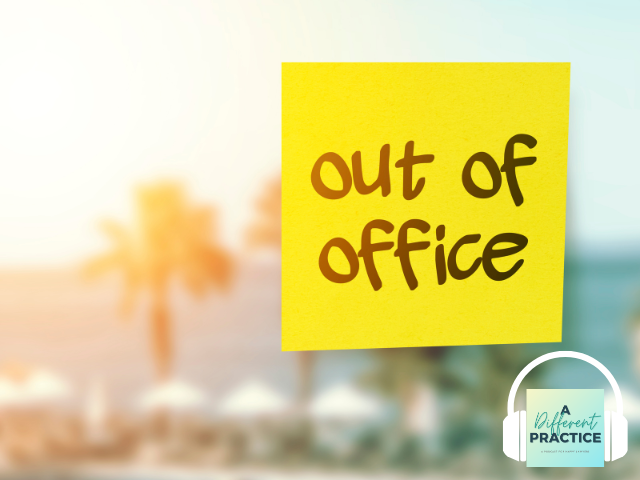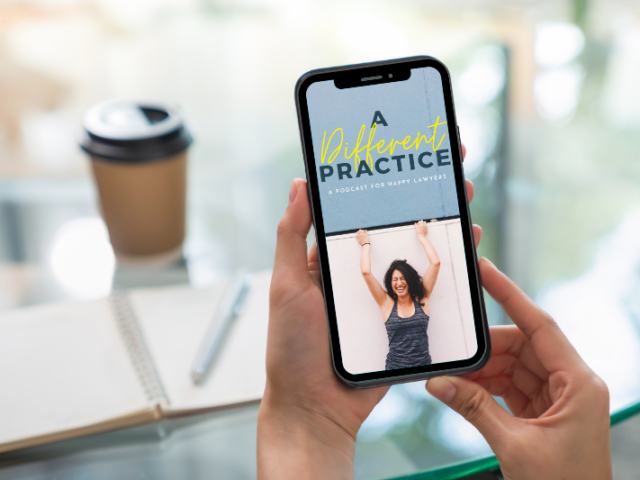Episode Description
When was your last real vacation? Not a “replying to client emails under a beach umbrella” kind of break—but an actual, restorative, inbox-free escape. If that question makes your eye twitch, this episode is for you.
I’m walking you through the exact 6-step system I use to plan and take real vacations as a solo attorney. You’ll learn how to protect your time off like it’s a court date, prep clients without guilt, set up a no-panic pre-vacation sprint, and come back without a mountain of chaos.
Vacations aren’t reckless. They’re a strategy. Tune in and learn how to finally take the time you need without your practice falling apart.
Listen Now!
Episode Transcript
LAUREN: [00:00:00] When was your last actual vacation? And no answering client emails under a beach umbrella while sipping a watered down margarita doesn’t count. If your break involves redlining contracts in an airport lounge, that’s just remote work and flip flops. Welcome to a different practice. I’m your host Lauren Lester, and I’m passionate about helping solo attorneys build thriving practices.
After starting my own solo firm, straight out of law school and building it to a successful practice that earns well over six figures while working part-time, I’m here to share the tools and strategies that made it possible. Think of this as grabbing coffee with your work bestie while learning everything they didn’t teach you about running a business in law school.
Pull up a seat and get ready to build a different practice. Welcome back to a different practice. I’m so glad you’re here. Thanks for showing up today. We’re talking about something US solo attorneys aren’t supposed to do. Disappear [00:01:00] and not disappear in the true crime sense, but disappear in terms of taking a break.
We’re told that taking a vacation is irresponsible, impossible, and even a little selfish. But here’s the truth. Those breaks don’t kill your practice. They protect it. They protect you. We don’t skip breaks because we’re lazy or disorganized. We avoid them because we’re scared. Scared of falling behind, scared of upsetting clients, scared of losing traction.
I have felt all of that too, whether you’re just starting out or you have built up your practice, taking a vacation can feel really hard. So much so that we just avoid it and we keep pushing through until, unfortunately, a lot of us get burned out. But here’s the good news. You can take a break and not just survive it, but come back better.
So today I’m gonna walk you through exactly how to do that, how I plan vacations in advance, how I prep clients, how I [00:02:00] try and avoid last minute scrambles. And yes, I even handle the occasional check-in without seething resentment. Plus, you’ll wanna stick around to the end for an update about what’s next for the podcast.
Before we dive into how to take a vacation, I wanna back up a little bit. See, earlier this year, I took a four day spring break trip with my family. Nothing fancy, just some time to rest, to be present, and to not refresh my inbox. And guess what? It actually worked not because I rolled the dice and ghosted my practice all of a sudden, but it worked because I planned for that vacation like it was a trial.
Was it easy? No. Did I pull some late nights before leaving? Yep. Was it worth it? Absolutely. That trip reminded me that rest isn’t indulgent. It’s strategic. It’s what allows us to keep showing up to our practices each and every day. So here are the six steps I took to be able to take that vacation and actually [00:03:00] disconnect from the practice and how you can too.
Step one, schedule your time away from the office like a trial. I find the best time to schedule vacations in particular. Those longer stretches of time is before the year even starts. I try to schedule my vacations for the upcoming year during the preceding holiday when it’s a little bit slow. Normally, I’m kind of planning for the next year to come.
I go ahead and stick in those vacation days ahead of time. That way I’m not stuck in July. Wondering if I could sneak in a few days in August because I just need a break. It’s already blocked out and it’s already protected. Now that doesn’t mean that opportunities or ideas don’t come up during the year, so if they’re booked out far enough, I’ll just move time around.
Maybe the first week in September that I was planning on is actually better for the third week in September. Or sometimes I’ll even add time. Maybe there’s an out of town CLE that I want to go to and I can extend my time to make it a little [00:04:00] bit of a break. I wasn’t planning on that, but if it’s far enough in advance, I’ll go ahead and add that to the calendar as well.
The key here is having enough runway to be able to implement the next five steps, so that when you do leave, you can actually take that break. So let’s talk about step two. Step two is tell clients what to expect more than once. When you take a vacation or any sort of break away from the office, you are not abandoning your clients.
You are being a human who needs to recharge in order to serve them better. Let clients know early, really early, almost so early that you feel like, oh, is this too early? I usually try and give clients a heads up at least a couple of weeks in advance. The longer that I’m gonna be out, the earlier, I’m gonna give them a heads up.
There’s a couple of different ways you can do this. You can go ahead and add it to your email signature, something like, I’ll be out of the office from this date to this date to disconnect and recharge. I will not be answering emails during this time. [00:05:00] Please do not reach out unless it’s an emergency. I.
You can tweak and edit that for whatever feels best to you. But going ahead and letting clients know ahead of time is going to help set the expectation. You can also post a message in your client portal and start to send it to individual clients. I try and look out, let’s say I’m gonna be out three weeks from now, if I have a client who’s getting close to potentially signing a prenup, or they’re almost done with their estate plan, and I know that they may wanna get it done before I leave.
I’m gonna start telling them that several weeks in advance to say, Hey, just as a heads up, I’m gonna be out starting this date. I’d love to get this wrapped up for you before then, but in order to do that X, Y, and Z needs to happen. Or can we go ahead and set the date for signing whatever it is? I will put a little bit of the onus on the client to help me help them get it done so that it’s one less thing that I have to be worrying about.
You can do something similar when you are scheduling meetings. Maybe [00:06:00] you have a new client who’s signing up and they need your kickoff meeting to be scheduled. You can let them know in that scheduling process. Let’s go ahead and find a date that works for all of us. Just a heads up, I’m gonna be out this period of time.
If we can make it work to get started ahead of time, great. If not, we’ll get together as soon as I get back. So it’s not something where it feels like you are abandoning them. And it’s just part of the natural flow of scheduling. But when you give them that heads up, weeks out in advance, they don’t feel like it snuck out of nowhere.
Or they had an expectation that they were gonna get this done in the next week. And when you tell them two days before you’re leaving that you’re gonna be out for two weeks. Right? That’s where the expectations can have some tension because the client had one idea. You had another. So being really upfront and just telling clients as soon as possible is gonna make it so much easier for you to actually step away.
You wanna be lovingly repetitive here. You may need to say it a few times for it to click with clients. And like I mentioned, you’re not just going to let clients know you’ll [00:07:00] be out and then do nothing on their matter when there’s actually work to be done. So that brings us to step three. Step three is the pre vacation sprint across all of your open cases.
You wanna look at deadlines, client needs, filings, hearings, and then create a pre vacation sprint checklist. Are you going to be a hundred percent caught up before you leave? Probably not, and that’s okay. But you wanna aim to clear the runway as much as you can so that nothing urgent is going to land while you’re gone.
As much as you can, try not to schedule court appearances or important meetings either the week before or the week after you’re going to be out, that will allow you to have a buffer to help. Ease the pressure and maintain some flexibility in case something unexpected does come up and you need to give it your attention before you leave or you need to work on it as soon as you get back.
The more you can do to be proactive on all of your cases, the better it [00:08:00] is going to be when you come back. We all have that sort of ramp up to when we leave and then when we come back. There’s a lot of stuff to do. I don’t know if we can eliminate that entirely, but we can certainly can minimize it by going through all of our cases and saying, what can I get done realistically, even if I have to push a little bit harder before I leave.
That way I can actually enjoy my leave from the office. But of course, because the unexpected does happen and we should plan for it, that brings us to step four, which is to tag in a backup, you wanna find a trusted colleague that you can trade favors with when each of you are going to be out of the office.
Then you let clients know, Hey, if an emergency arises, contact attorney and then give them their name and contact information. Put this in your autoresponder so that folks know if you have one. You can also let your assistant know the drill. And then most importantly, let your colleague know that they have the authority to use their discretion on whether an issue is really an emergency.
That [00:09:00] way they don’t feel they have to take on everything that might come up for clients. You can also tell your backup attorney that they can reach out to you if they need to. Most colleagues are not going to do this unless it’s absolutely necessary, right? They get it. We’re all in the same boat, but they will feel better if you let them know, Hey, if you really need to reach out to me, not a big deal.
And that way your colleague has that safety valve that they can pull. It gives you peace of mind that if anything comes up, it’s taken care of and it gives them coverage so that they know it’s not entirely on their lap. Talk through with your colleague ahead of time so that you have those expectations laid out from the jump, and that will help both of you know what to expect.
And speaking of expectations, step five is to set your own boundaries. I. If you’re taking a few days to maybe a week off, you can probably go totally offline, especially if you’ve gotten these other steps in place. But if we’re talking like a two to three week trip, you have to decide ahead of time if and how you’ll check in.
So [00:10:00] personally, I schedule a 30 minute check-in once or twice a week. Maybe you have a wifi Wednesday while you’re on vacation, like make it a little bit fun, right? Have a little daiquiri with you when you’re doing it and that way. You’re not half checking emails every day, you know, waiting in line somewhere and you pick up your phone and you’re scrolling through.
You really can disconnect, but you’re choosing when to reconnect. Just to do a quick check-in, and that’s the point of this time is a quick check-in. It’s not to sit there and respond to every single email to deal with every task that might come up and trust me. I am saying this to myself as a reminder because I have to fight that urge when I open up my inbox and there are double or triple digit new emails that I, that I’m gonna need to deal with at some point, my urge is to just go ahead and knock those out.
So my 30 minutes right then turns into three hours probably. You have to resist that urge to respond and clear out all the emails. Instead, this is a time when I’m just scanning through to see if anything [00:11:00] truly urgent came up or some critical need that needs to be addressed. Maybe it’s something where a quick response will keep things moving without you.
For example, you just need to confirm a date for when a notary can come to the client to get their estate planning document signed. You shooting off a quick email will keep that process going and it only takes you a few minutes. And because you set those expectations with clients weeks in advance, you don’t need to respond with, I’m out of the office.
I’ll get back to you when I return. Certainly, hopefully your autoresponder is already doing that, but they know that you’re out of the office and oftentimes what I will get is clients saying, Hey, I know you’re out of the office, but. Here’s this question I have for when you get back. It was something that was on their mind.
They sent it to me, but they don’t have an expectation that I’m going to respond within that time period because I already let them know that I’m gonna be out. So decide ahead of time if and when you will. Check in what that looks like, and use the time for a quick scan just to make sure that there’s nothing you need to respond to immediately.
That is an actual emergency. Then [00:12:00] close the laptop and get back to your break. All right. That brings us to the last step, step six. Automate like a boss. Update your out of office responder. Just talked about that. Make sure that that’s set up so that folks know that you are out of the office. Set up any automatic email replies.
Maybe you have something set up where if certain phrases or words are in an email, there’s a certain reply that goes out automatically if you have one. You can prep your assistant with scripts for common client questions that might come up while you’re gone. That way they’re ready to go. And if you don’t have an assistant.
You could also consider posting those common questions maybe on a site or within your client portal where clients would have access to them. So if they do have more routine questions, they can go ahead and check that FAQ before sending you an email. Hopefully that cuts down on the emails that you have to respond to when you get back, and it also gives the client at least a more immediate response.
What I have found is that clients want some form of communication more than they want the immediate [00:13:00] response. If they know what’s going on with their case ahead of time, if they know when I’ll be out, if it’s something that they can take care of themselves, they often will. When I was in the height of my family law practice, as long as I set expectations early and got cases to as good of a spot as I could.
Most clients were really respectful and didn’t bother me unless they really needed to. And then, like I mentioned, I had that colleague who acted as a gatekeeper who could reach out to me if there really was an emergency or something I needed to deal with. But most of the time they were there to just tell the client, Hey, this seems like an emergency.
It’s very important to you, but you actually have some time and this is something that Lauren can address when she’s. Back that made the client feel better to hear something, not necessarily to have a full resolution. And I think that’s something that we have to remind ourselves while we are on this break is we don’t have to fix every single thing.
It can likely wait and it’s just the client being able to know, Hey, I heard you and I will get to this when I’m [00:14:00] back. Alright, so before we wrap up, let’s quickly recap those steps. One, schedule your breaks like a trial. Two, tell clients what to expect more than once. Three, plan your pre vacation sprint so you can be as proactive to get as much done before you leave.
Four. Tag in a backup so you know that things are taken care of. If they do come up. Five, set your own boundaries of if and when you will check in. And six, automate like a boss. If you do those, you’re not just taking a vacation, you’re reclaiming your time intentionally. So right now I want you to pull up your calendar and pick a week, any week doesn’t matter, and block it off.
It could be a month from now, it can be six months from now. It doesn’t matter. But this is your first move and being able to take that break and truly disconnect to recharge. No one is gonna drop PTO into your lap. When you run the business. You have to take it for yourself. And if going in and blocking out a week right now makes your [00:15:00] stomach turn a little bit, that likely means you really need that break.
So go ahead and plan for it. You absolutely deserve it. And speaking of breaks, I am taking one myself. This is going to be the last podcast episode for a little while. I’m going on hiatus not to kick back at the beach somewhere, although tempting, but to work on building something new. I’m working on putting together more practical tools just for solo attorneys.
So think. Bite-size resources on pricing and marketing systems, finances, stuff that you can actually use in an hour or less to improve your practice and continue to build it in a way that works for you. That’s all I’m gonna say for now, but trust me, it is going to be so good in the meantime. You’ve got over a hundred episodes here.
Oh my gosh, I can’t believe that. So go back, revisit them. There is gold in the archive. And hey, if you’re looking for community, come hang out with me on Substack. I’ll still be posting over there Tools, behind the scenes updates, answers to questions. [00:16:00] It’s where we can stay connected because here’s what I’ve learned, the hardest part of being a solo.
Is being solo. It’s not always easy to find people who get it, but this community does, and I am so, so grateful for that. So join the conversation@adifferentpractice.com slash subscribe. It’s free, it’s supportive, and it’s made just for you. I will miss y’all during this break, but I can’t wait to show you what’s next.
Until next time, keep building a different practice. Thanks for joining me on another episode of a different practice. If you found value in today’s conversation, subscribe to my Solo Success Lab newsletter, where each week I test and share what actually works in solo practice. Sign up for free@adifferentpractice.com slash subscribe.
Wanna help other lawyers transform their practices too? Follow the show. Leave a rating and share this episode with someone who might benefit. And if you’re ready to take your practice to the next level, download my free guide to the six pillars of [00:17:00] optimization@adifferentpractice.com slash optimize.
I’ve distilled nearly a decade of experience, including all the mistakes and victories into the essential elements every successful law firm needs. I’ll see you next time, and until then, keep building a different practice.





